The pressure on boards of directors to oversee and manage risk is greater than ever before. Today's corporate world faces increased scrutiny, along with the strongest advancements in technology that we've ever seen. These are two very good reasons for boards to place a heavy focus on overseeing risk management. Risk is a fundamental issue in a company's organizational strategy.
Across the world, technology has sped up the process of business transactions. In turn, it's created a need to increase product volumes and the pace of product cycles. Technology has created a wealth of new opportunities, risks and complexities. The pace of corporate America builds and destroys corporations within seconds.
The topics of risk assessment and risk management have become robust areas of discussion for audit committees, as required by the New York Stock Exchange. Commercial credit rating agencies, such as Standard & Poor's, now require an assessment of commercial risk management procedures and processes. Risk management issues are gradually becoming more frequent items on board agendas.
The consequences of poor risk management can be steep, as corporations can face civil and statutory offenses, fines and other devastating legal complications. In addition to penalties and legal implications, failing to manage risks responsibly can result in exorbitant insurance costs, increased costs for loss control measures, added expenses for managing claims and increased administrative costs.
Every opportunity carries risk with it, and the complexity of the corporate world makes finding a successful balance between risk and reward extremely difficult.
Starting with their business model, boards need to assess their business model for risks that affect their viability. It's crucial for boards and management teams to be on the same page relative to the company's risk appetite and how they intend to pursue creating shareholder and consumer value. Board and management discussions must center around the company's key success drivers and an assessment of the risks in the company's strategy. Boards should pay attention to the important relationship between risk and success because risks can easily threaten the business model.
The board and its standing committees should all be clear on their responsibilities for oversight. Generally, committees take on various areas of oversight, while the board takes on the primary responsibility for overall risk oversight. Board oversight includes the following five areas:
Board directors should have a willingness to challenge managers on their data and assumptions. In times of crisis, it's especially important for board members to challenge managers. In times of prosperity, boards should not only applaud the company's success, they also need to consider that negative consequences may surface at any time and expose the company to failure.
Still another risk that board directors need to invest time and attention in is one that is becoming an increasing concern for shareholders, and that has to do with the company's culture and the incentive structure for executives. Risk is pervasive in a company's decision-making and operating processes. The board's decisions in these areas bring the organization's values to light.
Boards must also work to align the critical components of strategy, controls, risks, incentives, compliance and personnel to form the strongest possible infrastructure. The risk of not getting this right will create a situation that makes it impossible for the company to execute its strategic plan. Forming the perfect alignment is difficult for managers to accomplish, as well as for boards to oversee.
Finally, the board self-evaluation process is a best practice activity that helps enhance the risk oversight process. Diligent Corporation offers an effective board self-evaluation tool as part of Governance Cloud, which is a suite of fully integrated software solutions for boards.
The board's risk oversight process should be considered a work in progress that occasionally needs reflection and refreshment.
Having a solid risk management plan in place isn't the cure for all that ails companies, but it will decrease the chance of having a degree of negative impact that could force a shutdown of the company.
Across the world, technology has sped up the process of business transactions. In turn, it's created a need to increase product volumes and the pace of product cycles. Technology has created a wealth of new opportunities, risks and complexities. The pace of corporate America builds and destroys corporations within seconds.
Corporate Risk Lies Under a Magnifying Glass
Risk management trends are swiftly shifting accountability from management to boards of directors. Boards of directors have to delve into the waters of risk management while facing stronger corporate governance rules and greater involvement by credit rating agencies. The vast amount of change is forcing boards to view past organizational exposure in a new light. At the same time, it's vital that boards look toward the future in overseeing current financial risks and exposures to deal with impending changes and crises.The topics of risk assessment and risk management have become robust areas of discussion for audit committees, as required by the New York Stock Exchange. Commercial credit rating agencies, such as Standard & Poor's, now require an assessment of commercial risk management procedures and processes. Risk management issues are gradually becoming more frequent items on board agendas.
Areas Expanding for Potential Loss
Potential losses include increases in expenses and decreases in profit margins. Corporations stand to lose personal property and real property as a result of exposure to financial loss. Today, there exists an increased risk of tangible and intangible property, as well as the loss of valuable personnel.The consequences of poor risk management can be steep, as corporations can face civil and statutory offenses, fines and other devastating legal complications. In addition to penalties and legal implications, failing to manage risks responsibly can result in exorbitant insurance costs, increased costs for loss control measures, added expenses for managing claims and increased administrative costs.
Every opportunity carries risk with it, and the complexity of the corporate world makes finding a successful balance between risk and reward extremely difficult.
Action Steps for Greater Board Oversight
Boards need to take innovative action steps to increase their oversight over corporate operations.Starting with their business model, boards need to assess their business model for risks that affect their viability. It's crucial for boards and management teams to be on the same page relative to the company's risk appetite and how they intend to pursue creating shareholder and consumer value. Board and management discussions must center around the company's key success drivers and an assessment of the risks in the company's strategy. Boards should pay attention to the important relationship between risk and success because risks can easily threaten the business model.
The board and its standing committees should all be clear on their responsibilities for oversight. Generally, committees take on various areas of oversight, while the board takes on the primary responsibility for overall risk oversight. Board oversight includes the following five areas:
- Governance risks
- Critical enterprise risks
- Board-approval risks
- Business management risk
- Emerging and nontraditional risks
Board directors should have a willingness to challenge managers on their data and assumptions. In times of crisis, it's especially important for board members to challenge managers. In times of prosperity, boards should not only applaud the company's success, they also need to consider that negative consequences may surface at any time and expose the company to failure.
Still another risk that board directors need to invest time and attention in is one that is becoming an increasing concern for shareholders, and that has to do with the company's culture and the incentive structure for executives. Risk is pervasive in a company's decision-making and operating processes. The board's decisions in these areas bring the organization's values to light.
Boards must also work to align the critical components of strategy, controls, risks, incentives, compliance and personnel to form the strongest possible infrastructure. The risk of not getting this right will create a situation that makes it impossible for the company to execute its strategic plan. Forming the perfect alignment is difficult for managers to accomplish, as well as for boards to oversee.
Anticipating Emerging Risks
Perhaps the most challenging part of overseeing risk management is trying to factor in the impact of emerging and interrelated risks. It's difficult to assess the impact of a potential, yet unforeseen, risk even when boards are able to get a wealth of information from internal and external sources. Risk management requires connecting all the dots that boards can see, as well as predicting which dots will appear and making a plan for them as well. Boards need to formulate a solid risk management plan and keep it flexible enough that they're prepared for changes and are ready to respond quickly and proactively rather than reactively.Finally, the board self-evaluation process is a best practice activity that helps enhance the risk oversight process. Diligent Corporation offers an effective board self-evaluation tool as part of Governance Cloud, which is a suite of fully integrated software solutions for boards.
The board's risk oversight process should be considered a work in progress that occasionally needs reflection and refreshment.
Having a solid risk management plan in place isn't the cure for all that ails companies, but it will decrease the chance of having a degree of negative impact that could force a shutdown of the company.





